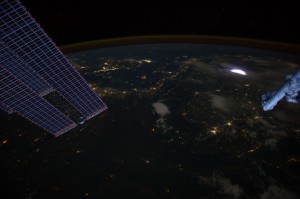Fortunately for astronauts, lighting surge isn't one of the electrical problems they're likely to encounter in space. On Earth, however, lighting surge protection is vital. Most transients induced by nearby lightning strikes result in an electromagnetic disturbance on electrical and communication lines connected to electronic equipment.
Devices that protect against these transients must have a fast response time and must be able to dissipate a large amount of energy. Devices typically used to protect against lighting surge damage include metal oxide varistors (MOVs), TVS diodes, and gas discharge tubes (GDTs). Protection thyristors and TVS diode arrays are often used for telecom/datacom applications.

Lightning viewed from space (Source: nasa.gov).
Solar flare activity is currently high because the sun's roughly 11-year activity cycle is ramping up toward solar maximum, which is likely to occur at some time in 2013. A solar flare is a sudden, rapid, and intense variation in the sun's brightness, which occurs when magnetic energy that has built up in the solar atmosphere is released suddenly. Radiation is emitted across virtually the entire electromagnetic spectrum.
Although the heat of a solar flare can't make it all the way through Earth's atmosphere, its electromagnetic radiation and energetic particles can. Solar flares can temporarily affect the upper atmosphere, disrupting signal transmissions from GPS and telecommunications satellites to Earth. Coronal mass ejections (CMEs), which often accompany solar flares, can be even more disruptive. These solar explosions fling masses of particles and electromagnetic fluctuations into Earth's atmosphere that could induce electric fluctuations at ground level that could blow out transformers in power grids. A CME's particles can also collide with crucial electronics onboard a satellite and disrupt its systems.
In 2010, NASA launched the Solar Dynamics Observatory, a sun-pointing semi-autonomous spacecraft to allow nearly continuous observations of the Sun. Its mission is to help scientists understand the causes of solar variability and its impacts on Earth.
Want to learn more about exciting NASA programs like this? Enter to win an Exploration & Discovery experience and go behind the scenes with NASA! Speed2Design is hosting TechTalk events at two premiere NASA facilities this year. Winners can meet NASA engineers involved in the NASA Technology Transfer Program. But time is running out - enter today.